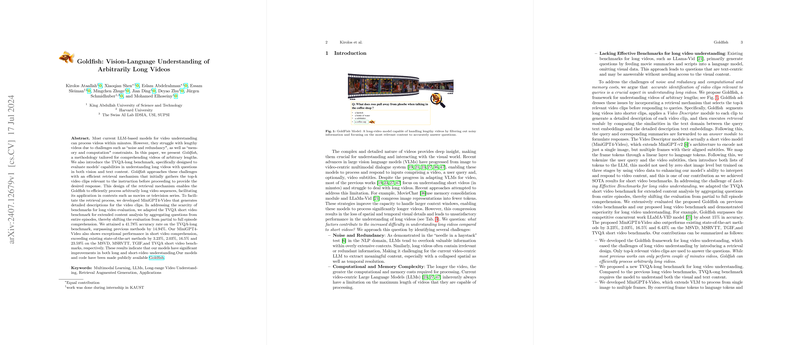Overview of Goldfish: Vision-Language Understanding of Arbitrarily Long Videos
The paper "Goldfish: Supplementary materials of Vision-Language Understanding of Arbitrarily Long Videos" introduces a novel methodology designed to handle video content of arbitrary lengths, overcoming the prevalent constraints of current LLMs in video understanding. The proposed framework, Goldfish, leverages an efficient retrieval mechanism to parse and comprehend lengthy videos by focusing on the top-k relevant video clips corresponding to a given query. This approach facilitates the practical application of video comprehension tasks in extensive video sequences such as movies or television series.
The authors present a comprehensive evaluation of the Goldfish model using the newly introduced TVQA-long benchmark, specifically developed to measure models' capabilities in understanding long videos. The experimental results demonstrate a notable improvement over existing methodologies, with Goldfish achieving a 41.78% accuracy rate on the TVQA-long benchmark, surpassing previous methods by 14.94%. Additionally, the MiniGPT4-video model, an integral component of Goldfish, exhibited exceptional performance on short video comprehension benchmarks, surpassing state-of-the-art methods on MSVD, MSRVTT, TGIF, and TVQA benchmarks.
Challenges in Long Video Understanding
The authors identify several key challenges faced by existing LLM-based models in processing lengthy videos:
- Noise and Redundancy: Long videos often contain extensive irrelevant or redundant information, making it difficult for LLMs to extract and focus on meaningful content.
- Computational and Memory Complexity: The resource requirements for processing longer videos increase exponentially, presenting significant computational and memory constraints.
- Lack of Comprehensive Benchmarks: Existing benchmarks for long video comprehension often fail to integrate visual data effectively, leading to an incomplete assessment of model capabilities.
Goldfish Framework
Goldfish addresses these challenges through a multi-stage framework that incorporates:
- Video Descriptor: This module segments long videos into shorter clips and generates detailed descriptions for each clip using MiniGPT4-video. The descriptions, along with video subtitles, are encoded into embeddings for further processing.
- Retrieval Module: The module identifies the top-k relevant video clips by comparing the embeddings of the video descriptions and subtitles against the query embedding.
- Answer Module: The module utilizes the retrieved top-k video clips to generate a coherent and accurate response to the query.
This retrieval-based design allows Goldfish to selectively process the most relevant portions of the video, mitigating the impact of noise and redundancy while enhancing computational efficiency.
MiniGPT4-video Model
The MiniGPT4-video model is an adaptation of existing vision-LLMs, extending their capabilities from single-image processing to handling multiple frames within a video. The model undergoes three stages of training:
- Large-scale image-text pair pretraining: Aligning visual features with the LLM's input space through image captioning.
- Large-scale video-text pair pretraining: Training the model on video caption datasets to interpret video content effectively.
- Video question answering instruction finetuning: Enhancing the model's ability to respond accurately to video-based queries.
Experimental Results
Goldfish and MiniGPT4-video were evaluated on multiple benchmarks for both short and long video comprehension tasks:
- TVQA-long Benchmark: Goldfish achieved an accuracy of 41.78%, surpassing previous methods by 14.94%.
- Short Video Benchmarks: MiniGPT4-video outperformed state-of-the-art methods with improvements of 3.23%, 2.03%, 16.5%, and 23.59% on the MSVD, MSRVTT, TGIF, and TVQA benchmarks, respectively.
- Retrieval Analysis: Ablation studies show the effectiveness of including both video summaries and subtitles in retrieval, with
k=3being optimal for balancing information richness and noise reduction.
Implications and Future Directions
The Goldfish framework significantly advances the state of the art in long video understanding by introducing a retrieval-based approach that efficiently processes large video datasets. The implications of this research are substantial for both practical applications and theoretical advancements in AI:
- Practical Implications: The ability to comprehend and generate responses for lengthy video content brings practical applications in media analysis, video summarization, and interactive systems for educational tools.
- Theoretical Implications: The research addresses fundamental limitations in current multimodal learning models, paving the way for future innovations in LLM-based video understanding.
Future developments could explore further optimization of retrieval mechanisms, the integration of additional modalities such as audio, and advancements in benchmark designs to provide a more rigorous evaluation of long video comprehension capabilities.
In conclusion, the Goldfish framework represents a significant step forward in the field of vision-language understanding, achieving robust performance in both short and long video comprehension tasks through its innovative retrieval-based design. The research findings provide valuable insights into addressing computational and memory constraints, and introduce effective methodologies for processing extensive video sequences.
